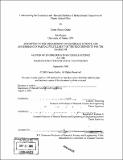Understanding the economics and material platform of bidirectional transceiver for plastic optical fiber
Author(s)
Gusho, Genta
DownloadFull printable version (4.338Mb)
Other Contributors
Massachusetts Institute of Technology. Dept. of Materials Science and Engineering.
Advisor
Randolph E. Kirchain, Jr.
Terms of use
Metadata
Show full item recordAbstract
Limitations of electrical wires result in distortion and dispersion of the signal for long distances. That have emerged optical communication as the only way of communication for long distances. For medium distances optics can support the high data rates required by the latest applications. Optical networks are becoming the dominant transmission medium as the data rate required by different applications increases. The bottleneck for implementing optical instead of electric networks for medium distances, like local area network, is the cost of the optical components and the cost of replacing the existing copper network. This thesis will discuss the possible cost benefits that come from the use of different materials like plastic optical fiber instead of silica fiber or Si, Si/Ge instead of InP or GaAs for the transceiver as well as the trade offs between the performance and cost when discrete transceiver is replaced by the monolithically integrated transceiver, by using a process based cost model.
Description
Thesis (M. Eng.)--Massachusetts Institute of Technology, Dept. of Materials Science and Engineering, 2005. Includes bibliographical references (leaves 74-76).
Date issued
2005Department
Massachusetts Institute of Technology. Department of Materials Science and EngineeringPublisher
Massachusetts Institute of Technology
Keywords
Materials Science and Engineering.